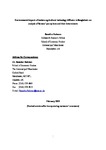Environmental impacts of modern agricultural technology diffusion in Bangladesh: an analysis of farmers' perceptions and their determinants
| dc.contributor.author | Rahman, Sanzidur | |
| dc.date.accessioned | 2015-12-25T11:47:03Z | |
| dc.date.available | 2015-12-25T11:47:03Z | |
| dc.date.issued | 2003-01-01 | |
| dc.identifier.issn | 0301-4797 | |
| dc.identifier.issn | 1095-8630 | |
| dc.identifier.uri | http://hdl.handle.net/10026.1/4032 | |
| dc.description.abstract |
Farmers' perception of the environmental impacts of modern agricultural technology diffusion and factors determining such awareness were examined using survey data from 21 villages in three agro-ecological regions of Bangladesh. Results reveal that farmers are well aware of the adverse environmental impacts of modern agricultural technology, although their awareness remains confined within visible impacts such as soil fertility, fish catches, and health effects. Their perception of intangible impacts such as, toxicity in water and soils is weak. Level and duration of modern agricultural technology adoption directly influence awareness of its adverse effects. Education and extension contacts also play an important role in raising awareness. Awareness is higher among farmers in developed regions, fertile locations and those with access to off-farm income sources. Promotion of education and strengthening extension services will boost farmers' environmental awareness. Infrastructure development and measures to replenish depleting soil fertility will also play a positive role in raising awareness. | |
| dc.format.extent | 183-191 | |
| dc.format.medium | ||
| dc.language | en | |
| dc.language.iso | en | |
| dc.publisher | Elsevier BV | |
| dc.subject | Bangladesh | |
| dc.subject | environmental impacts | |
| dc.subject | 'green revolution' | |
| dc.subject | multivariate analysis | |
| dc.title | Environmental impacts of modern agricultural technology diffusion in Bangladesh: an analysis of farmers' perceptions and their determinants | |
| dc.type | journal-article | |
| dc.type | Journal Article | |
| plymouth.author-url | https://www.webofscience.com/api/gateway?GWVersion=2&SrcApp=PARTNER_APP&SrcAuth=LinksAMR&KeyUT=WOS:000183871200008&DestLinkType=FullRecord&DestApp=ALL_WOS&UsrCustomerID=11bb513d99f797142bcfeffcc58ea008 | |
| plymouth.issue | 2 | |
| plymouth.volume | 68 | |
| plymouth.publication-status | Published | |
| plymouth.journal | Journal of Environmental Management | |
| dc.identifier.doi | 10.1016/s0301-4797(03)00066-5 | |
| plymouth.organisational-group | /Plymouth | |
| plymouth.organisational-group | /Plymouth/Faculty of Arts, Humanities and Business | |
| plymouth.organisational-group | /Plymouth/Users by role | |
| dc.publisher.place | England | |
| dc.identifier.eissn | 1095-8630 | |
| dc.rights.embargoperiod | Not known | |
| rioxxterms.versionofrecord | 10.1016/s0301-4797(03)00066-5 | |
| rioxxterms.licenseref.uri | http://www.rioxx.net/licenses/all-rights-reserved | |
| rioxxterms.type | Journal Article/Review |


